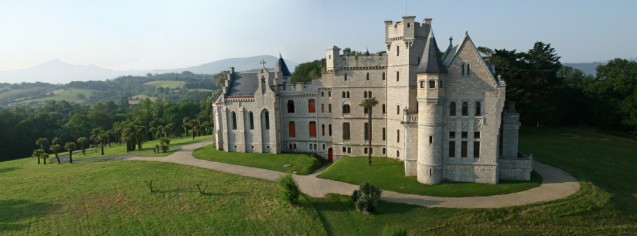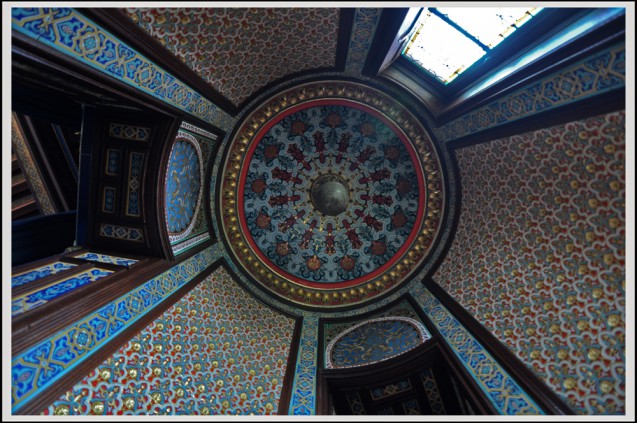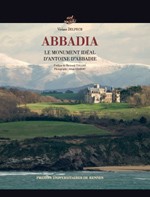Irène Delage: You could say that your book was a double biography, of the extraordinary house near Hendaye (Basque region of France) and of Antoine d’Abbadie and his wife Virginie, who commissioned the house. Who were they?
Viviane Delpech: Yes, the book is an attempt to explain the unusual and extravagant nature of the Château d'Abbadia and at the same time to link this to the remarkable life of the couple who commissioned it, Antoine and Virginie d'Abbadie. The aesthetic of the building – and that of the surrounding parkland – is basically a synthesis of their tastes, experiences and their Romantic and paradoxical view of the world, reactionary yet at the same time progressive, logical but irrational.
Antoine d'Abbadie was born in 1810 in Dublin, son of a Basque royalist who had emigrated at the beginning of the French Revolution and his Irish Catholic wife. On moving to Restoration France at the age of eight, he became fascinated by the sciences, developed the idea that he wanted to discover the source of the Nile, and also became deeply religious. After several years of preparation, in 1836 Arago gave him his first scientific mission, namely to chart magnetic variations in the southern hemisphere, in Brazil. It was on the frigate Andromède that d'Abbadie met Louis-Napoléon Bonaparte, briefly exiled to the United States as a result of the failed coup d'état in Strasbourg. The future emperor would later present d'Abbadie to his wife Eugénie as his “fortune teller” because d'Abbadie had predicted the former's political rise. However, this political “entente” was to deteriorate after the Italian campaign of 1859. D'Abbadie, as a confirmed Legitimist, could not countenance the invasion of the Papal States.
In 1837, a year after his first mission, the young scientist combined his interests and his ambition to discover the source of the Nile, undertaking an expedition to explore Ethiopia, where he was to live for eleven years. Back in France, he moved to Paris and the Basque corniche, where he had bought some acres of land before undertaking his great voyage, and he dedicated himself to his writings on Ethiopia, astronomy, geophysics and Basque culture – he was one of the great exponents of the rebirth of this local identity. In this, he was closely linked to Prince Louis-Lucien Bonaparte, well known for his erudition and his interest in philology and who shared d'Abbadie's fascination for the Basque language.
It was also after his return from Ethiopia that d'Abbadie decided to build his residence in the Basque country and to live there. In his emotional life, however, it took him nine long years of searching (rather like the Romantic passions so popular in the literature of the time) to find the love of his life, namely Virginie Vincent de Saint-Bonnet, eighteen years his junior and daughter of a high-society family from Lyons. They were to marry in 1859. Like every women of her time and social status, she played the role of guardian of the household and expended a great deal of energy, indeed sometimes more so than her husband, in the building of their Château. Virginie d'Abbadie was a woman of great austerity but also great originality, attentive to Catholic values but also non-conformist, a sort of feminist before her time. However she was often (willingly) in the shadow of her husband, though she shared his exalted erudition.
It was in 1864, after many years of hesitation and dithering with initial architects, that the d'Abbadies called on Eugène-Emmanuel Viollet-le-Duc, famed at the time for his restoration work at Vézelay, Notre-Dame de Paris and Pierrefonds, to be the architect of their project to build a combined habitation, chapel and observatory “in the Ogival style”. In sum, Abbadia was the home of a savant of varied interests – at times astronomer, geographer, geophysicist, ethnologist, historian, Catholic apologist and Orientalist – very much typical of the nineteenth century. D'Abbadie was however sufficiently energetic, and indeed megalomaniac, to be able to realise his wild dream of building a house in his own image, a sort of stone testament.
Irène Delage: It is a very eclectic château set on a wild promontory on the Basque coast. Would you say that Abbadia was “an ideal monument”? Indeed, what sort of building did Antoine d’Abbadie want?

Viviane Delpech: What d'Abbadie wanted was bourgeois apartments matching his social status, juxtaposed with a large chapel and an astro-geophysical observatory. The whole was supposed to be a conflation of high society, religion and science. Viollet-le-Duc's use of archaeological Neogothic style meant that Abbadia would reflect the eclecticism very much in vogue during the Second Empire, though mixed with Oriental features and modern commodity. The turrets and battlements were topped with mediaeval and occasionally exotic beasts; the Oriental rooms stood cheek by jowl with decoration inspired by the Middle Ages; mysticism went hand in hand with logic and study of the real world; the parkland was carefully brought to a level of studied savagery, the whole obeying the laws of contemporary hygenism but also evocative, designed to make viewers lose themselves in contemplation.
The château was built and decorated by Viollet-le-Duc and Edmond Duthoit in the period from 1864 to 1884. It was sited between the ocean, meadows and mountains at the heart of a spectacular, picturesque park landscaped by Eugène Bühler, close friend of d'Abbadie for nearly fifty years. It was an eclectic residence that the d'Abbadies built, partly the product of reason partly that of the imagination. What they built was in fact a distillation of their worldview, Romantic in its reconstruction of an idealised feudal society, buttressed by their Legitimist and Ultramontane political and religious beliefs. The thirty-five “bondsmen” on the estate also played a role in this restoration of feudal France, not only cultivating their parcels of land and going to Mass in the château chapel, but also willingly being subservient to the Christian morality imposed upon them by their masters in the big house.
Alongside this, d'Abbadie wanted his château to be a place of science, as the observatory stocked with all the latest scientific machinery shows. But there was also the vast library (more than 10,000 volumes) including three hundred Ethiopian manuscripts and 1,136 books in Basque, books which became part of the Bibliothèque nationale de France in 1902.
In fact, d'Abbadie's project crystallizes his pre-occupation for the transmission of learning and his heritage. For this reason, he bequeathed his château to the Académie des sciences, a decision which came into effect in 1896. The dozen or so Romantic but also moralising phrases that adorn the château and d'Abbadie's tomb in the chapel crypt complete this manifestation of d'Abbadie's conversation with the world. Abbadia is a work that lives, a territorial entity that thrives; it is the embodiment of d'Abbadie's ideals, a sort of Baconian utopia mixing science and religion, an evocation of his remembrances and his morality, all in all, an architectural project that is a monument to his ideals and a celebration of his own existence.
Irène Delage: In 1864, Antoine d’Abbadie called on Eugène Viollet-le-Duc and Edmond Duthoit for the realisation of his project. He included in this the landscape gardener, Eugène Bühler. What were the major features of the input of these architects?

Viviane Delpech: Abbadia was from the start as much a landscaping, as it was an architectural, project. Eugène Bühler's role in this was fundamental. First, because he was at d'Abbadie's side at the start of the project in the early 1850s, and second, because he stayed with him right to the latter's death in 1897. Moreover, Bühler was not just an architecture and decoration consultant, he had designed hundreds of gardens in France, both public and private, and at Abbadia he built a territorial ensemble with the château at the heart. The service roads and agricultural sites were perfectly harmonised with the purely decorative spaces. Here the natural and the monumental are married on this superb site – which included the Rhune mountain, its grassy slopes and rocky peaks, the Biarritz lighthouse, the church at Fontarrabie etc.- with the curvaceous lines and wooded thickets on the immense estate, whilst at the same preserving a certain evocative wildness. The park seems totally natural despite bearing fully the imprint of the hand of man. It was Bühler who defined the emplacement of the château with respect to these spectacular man-made viewpoints, and it was from this starting point that the architects were to design their building. The château, Abbadia, then should not be seen as a random, stand-alone project, but rather as one element of a territorial ensemble, reflecting on the one hand garden design practice since the Renaissance, and the rationalist ideals expressed by Viollet-le-Duc, on the other.
As for the architecture and the decoration, these were executed by the dynamic duo, Eugène Viollet-le-Duc and his faithful disciple Edmond Duthoit. Viollet-le-Duc made the plans and elevations for the residence and the chapel, whilst Duthoit was responsible on site and for the decoration and furnishing design. As usual, Viollet-le-Duc, however, designed the sculpted bestiary, and Duthoit alone oversaw the building of the astronomical observatory and its ornamental sculptures; this was in fact a second observatory, replacing that built by Parent before 1864. That being said, Duthoit's role in the affair was anything but straightforward. It is true that he can be observed meekly copying his master's projects, especially those from Dictionnaire raisonné du mobilier, and yet he also can be seen providing original decor, such as the Ethiopian paintings done in the Neogothic style championed by Viollet-le-Duc. However, up to 1871, Viollet-le-Duc retained the final say on site, despite the fact that Duthoit was nominally in charge of this. The two men managed to adapt themselves to d'Abbadie's wishes whilst still remaining true to their rationalist and nationalist ideals, something they had not managed to do on other projects. The clumped, irregular plan and the use of materials nicely illustrate their theories of functionalism inherited from the best practice of the masters of the Middle Ages. The Neogothic style was a marker of national identity, and with its use Viollet-le-Duc hoped for a renaissance in the arts. As for the Orientalist references desired by d'Abbadie, they could have found no better ambassador than Duthoit, who, after being taught by Viollet-le-Duc, had travelled in the East to complete his architectural training and who was appointed architect for the Commission des Monuments Historiques in Algeria in 1872. At Abbadia, he made a mixture of what he had seen during his voyages, namely, Byzantine, Moorish and Sicilian art, proposing not only a hybrid decoration but also, in the case of the Ethiopian paintings, one that was crossbred.
Finally, we should not forget that, despite the illusion of the Mediaeval and the Oriental, Abbadia was also a residence of its time. Its essence is due also to period building practice current in French seaside resorts. Recourse was had to methods promoted by the Industrial Revolution, such as mass production and purchases made in department stores. The patrons and architects depended on a network of more than one hundred contemporary artists and craftsmen and women, from Parvillée to Brocard, from Poussièlgue-Rusand to Chertier, from Dantan to Guignet, something that makes Abbadia a valuable snapshot of the state of the architecture and decoration market in the nineteenth century, particularly during the Second Empire.
(Translation: Peter Hicks)


